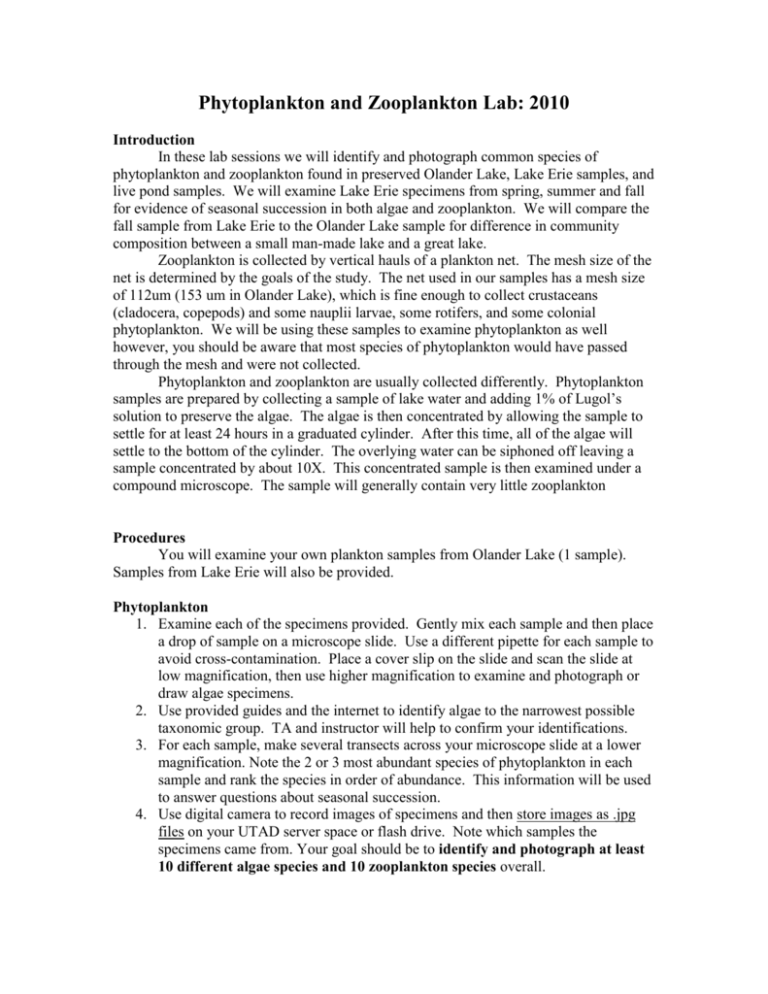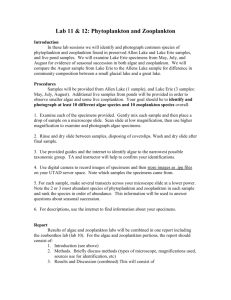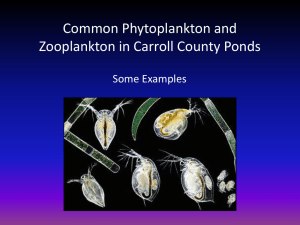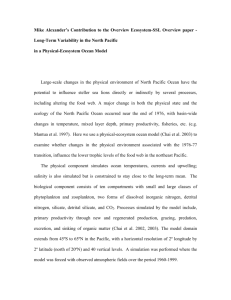Lab 4: Lake and River Water Chemistry
advertisement

Phytoplankton and Zooplankton Lab: 2010 Introduction In these lab sessions we will identify and photograph common species of phytoplankton and zooplankton found in preserved Olander Lake, Lake Erie samples, and live pond samples. We will examine Lake Erie specimens from spring, summer and fall for evidence of seasonal succession in both algae and zooplankton. We will compare the fall sample from Lake Erie to the Olander Lake sample for difference in community composition between a small man-made lake and a great lake. Zooplankton is collected by vertical hauls of a plankton net. The mesh size of the net is determined by the goals of the study. The net used in our samples has a mesh size of 112um (153 um in Olander Lake), which is fine enough to collect crustaceans (cladocera, copepods) and some nauplii larvae, some rotifers, and some colonial phytoplankton. We will be using these samples to examine phytoplankton as well however, you should be aware that most species of phytoplankton would have passed through the mesh and were not collected. Phytoplankton and zooplankton are usually collected differently. Phytoplankton samples are prepared by collecting a sample of lake water and adding 1% of Lugol’s solution to preserve the algae. The algae is then concentrated by allowing the sample to settle for at least 24 hours in a graduated cylinder. After this time, all of the algae will settle to the bottom of the cylinder. The overlying water can be siphoned off leaving a sample concentrated by about 10X. This concentrated sample is then examined under a compound microscope. The sample will generally contain very little zooplankton Procedures You will examine your own plankton samples from Olander Lake (1 sample). Samples from Lake Erie will also be provided. Phytoplankton 1. Examine each of the specimens provided. Gently mix each sample and then place a drop of sample on a microscope slide. Use a different pipette for each sample to avoid cross-contamination. Place a cover slip on the slide and scan the slide at low magnification, then use higher magnification to examine and photograph or draw algae specimens. 2. Use provided guides and the internet to identify algae to the narrowest possible taxonomic group. TA and instructor will help to confirm your identifications. 3. For each sample, make several transects across your microscope slide at a lower magnification. Note the 2 or 3 most abundant species of phytoplankton in each sample and rank the species in order of abundance. This information will be used to answer questions about seasonal succession. 4. Use digital camera to record images of specimens and then store images as .jpg files on your UTAD server space or flash drive. Note which samples the specimens came from. Your goal should be to identify and photograph at least 10 different algae species and 10 zooplankton species overall. 5. Rinse and dry slide between samples, disposing of coverslips. Wash and dry slide after final sample. Zooplankton 1. Examine each of the specimens provided. Gently mix each sample and then place a few drop of sample on a microscope slide using a wide-bore pipette. Rinse the pipette between samples to avoid cross-contamination. Don’t use a cover slip because this will crush the specimens. Scan the slide at low magnification, then use higher magnification to examine and photograph zooplankton specimens. 2. Use provided guides and the internet to identify zooplankton to the narrowest possible taxonomic group. TA and instructor will help to confirm your identifications. 3. Use a wide-bore pipette to dispense 2-3 ml of sample into a petri dish and examine using a dissecting scope. Note the 2 or 3 most abundant taxa of zooplankton in each sample and rank the taxa in order of abundance. This information will be used to answer questions about seasonal succession. Return specimens to the sample bottle. 4. Use digital camera to record images of specimens and then store images as .jpg files on your UTAD server space or flash drive. Note which samples the specimens came from. Your goal should be to identify and photograph up to10 different algae species and 10 zooplankton species overall. Report Results of algae and zooplankton labs will be combined in one report. For the algae and zooplankton portions, the report should consist of: 1. Introduction. Briefly introduce the role of zooplankton and phytoplankton in aquatic systems. Introduce the objectives of the lab exercise. 2. Methods. Briefly discuss methods (types of microscope, magnifications used, sources use for identification, etc) 3. Results and Discussion (combined) This will consist of a. digital images of algae and zooplankton pasted into your report. Each image should be accompanied by a caption describing the specimen identification, date and location, and magnification. For example “Figure 1. Asterionella sp. colony (400x), Lake Erie, May 21, 2007” Note that genus and species names are generally italicized. If unable to capture images on microscopes, please use images from the web. b. A brief paragraph describing the habitat of each specimen. i. For algae, this description may include whether this species prefers productive or unproductive lakes (high P or lower P), prefers spring, winter, or fall. Mixing or stratified conditions, etc. – and anything interesting you read about this species. ii. For zooplankton, also describe preferred habitats and whether the species is a grazer (herbivore), omnivore or a predator. 4. Create a small table similar to the one below to summarize the relative dominance of the most common zooplankton and phytoplankton species in the Lake Erie and Olander Lake samples. The table might look something like this: Taxa Pediastrum Fragilaria Asterionella Microcystis Dinobryan LE (May) LE (July) 1 1 2 3 2 3 Cyclopoid Cop Calanoid Cop Daphnia Bosmina Diaphanosma 1 2 3 1 2 3 LE (Aug) 1 2 3 Allen (Sept) 3 2 1 2 1 2 3 3 1 5. Discuss your answers to questions regarding dominant species, predation, and seasonal succession. Questions 1. Did you find any evidence of seasonal succession of phytoplankton and zooplankton in Lake Erie between May and August? Use your table to describe how the phytoplankton and zooplankton communities changed over time. (Graduate Students: Find one online or text source to support whether your observation is typical or atypical of temperate zone lakes) 2. How are the phytoplankton and zooplankton communities alike and different between Olander Lake and Lake Erie (Fall sample)? a. What do the algal communities suggest about nutrient and mixing differences between the two lakes? (Graduate Students: Find an internet or text source to support your answer) b. What do the zooplankton communities suggest regarding differences in fish or invertebrate predation between the two lakes? (Graduate Students: Find an internet or text source to support your answer) 3. Did you find any exotic (non-native) species in your samples? List them and the possible methods of entry into the lake. 4. Did you find any zooplankton predators in your samples? List them. What prey species did you find in the same sample with the predator?






